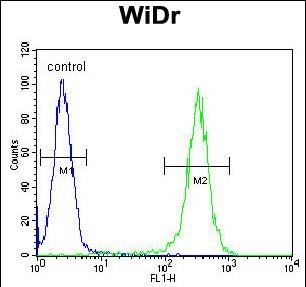B4GALT5 Antibody (C-term)
Affinity Purified Rabbit Polyclonal Antibody (Pab)
- SPECIFICATION
- CITATIONS
- PROTOCOLS
- BACKGROUND

Application
| FC, WB, E |
|---|---|
| Primary Accession | O43286 |
| Other Accession | Q9JMK0, NP_004767.1 |
| Reactivity | Human, Mouse |
| Host | Rabbit |
| Clonality | Polyclonal |
| Isotype | Rabbit IgG |
| Calculated MW | 45119 Da |
| Antigen Region | 324-350 aa |
| Gene ID | 9334 |
|---|---|
| Other Names | Beta-1, 4-galactosyltransferase 5, Beta-1, 4-GalTase 5, Beta4Gal-T5, b4Gal-T5, 241-, Beta-1, 4-GalT II, UDP-Gal:beta-GlcNAc beta-1, 4-galactosyltransferase 5, UDP-galactose:beta-N-acetylglucosamine beta-1, 4-galactosyltransferase 5, B4GALT5 |
| Target/Specificity | This B4GALT5 antibody is generated from rabbits immunized with a KLH conjugated synthetic peptide between 324-350 amino acids from the C-terminal region of human B4GALT5. |
| Dilution | FC~~1:10~50 WB~~1:1000 E~~Use at an assay dependent concentration. |
| Format | Purified polyclonal antibody supplied in PBS with 0.09% (W/V) sodium azide. This antibody is purified through a protein A column, followed by peptide affinity purification. |
| Storage | Maintain refrigerated at 2-8°C for up to 2 weeks. For long term storage store at -20°C in small aliquots to prevent freeze-thaw cycles. |
| Precautions | B4GALT5 Antibody (C-term) is for research use only and not for use in diagnostic or therapeutic procedures. |
| Name | B4GALT5 (HGNC:928) |
|---|---|
| Function | Catalyzes the synthesis of lactosylceramide (LacCer) via the transfer of galactose from UDP-galactose to glucosylceramide (GlcCer) (PubMed:24498430). LacCer is the starting point in the biosynthesis of all gangliosides (membrane-bound glycosphingolipids) which play pivotal roles in the CNS including neuronal maturation and axonal and myelin formation (By similarity). Plays a role in the glycosylation of BMPR1A and regulation of its protein stability (By similarity). Essential for extraembryonic development during early embryogenesis (By similarity). |
| Cellular Location | Golgi apparatus, Golgi stack membrane {ECO:0000250|UniProtKB:P15291}; Single-pass type II membrane protein Golgi apparatus {ECO:0000250|UniProtKB:A0A1S6M251}. Note=Trans cisternae of Golgi stack. {ECO:0000250|UniProtKB:P15291} |
| Tissue Location | Ubiquitously expressed. |

Thousands of laboratories across the world have published research that depended on the performance of antibodies from Abcepta to advance their research. Check out links to articles that cite our products in major peer-reviewed journals, organized by research category.
info@abcepta.com, and receive a free "I Love Antibodies" mug.
Provided below are standard protocols that you may find useful for product applications.
Background
This gene is one of seven beta-1,4-galactosyltransferase (beta4GalT) genes. They encode type II membrane-bound glycoproteins that appear to have exclusive specificity for the donor substrate UDP-galactose; all transfer galactose in a beta1,4 linkage to similar acceptor sugars: GlcNAc, Glc, and Xyl. Each beta4GalT has a distinct function in the biosynthesis of different glycoconjugates and saccharide structures. As type II membrane proteins, they have an N-terminal hydrophobic signal sequence that directs the protein to the Golgi apparatus and which then remains uncleaved to function as a transmembrane anchor. By sequence similarity, the beta4GalTs form four groups: beta4GalT1 and beta4GalT2, beta4GalT3 and beta4GalT4, beta4GalT5 and beta4GalT6, and beta4GalT7. The function of the enzyme encoded by this gene is not clear. This gene was previously designated as B4GALT4 but was renamed to B4GALT5. In the literature it is also referred to as beta4GalT2. [provided by RefSeq].
References
Kitayama, K., et al. J. Biol. Chem. 282(41):30085-30096(2007)
Sato, T., et al. J. Biol. Chem. 282(38):27702-27712(2007)
Jiang, J., et al. J. Biol. Chem. 281(14):9482-9489(2006)
Sato, T., et al. J. Biol. Chem. 279(38):39574-39583(2004)
Xu, S., et al. J. Exp. Clin. Cancer Res. 21(3):409-414(2002)
Deloukas, P., et al. Nature 414(6866):865-871(2001)
Amado, M., et al. Biochim. Biophys. Acta 1473(1):35-53(1999)
Lo, N.W., et al. Glycobiology 8(5):517-526(1998)
Sato, T., et al. Biochem. Biophys. Res. Commun. 244(3):637-641(1998)
Sato, T., et al. Proc. Natl. Acad. Sci. U.S.A. 95(2):472-477(1998)
If you have used an Abcepta product and would like to share how it has performed, please click on the "Submit Review" button and provide the requested information. Our staff will examine and post your review and contact you if needed.
If you have any additional inquiries please email technical services at tech@abcepta.com.













 Foundational characteristics of cancer include proliferation, angiogenesis, migration, evasion of apoptosis, and cellular immortality. Find key markers for these cellular processes and antibodies to detect them.
Foundational characteristics of cancer include proliferation, angiogenesis, migration, evasion of apoptosis, and cellular immortality. Find key markers for these cellular processes and antibodies to detect them. The SUMOplot™ Analysis Program predicts and scores sumoylation sites in your protein. SUMOylation is a post-translational modification involved in various cellular processes, such as nuclear-cytosolic transport, transcriptional regulation, apoptosis, protein stability, response to stress, and progression through the cell cycle.
The SUMOplot™ Analysis Program predicts and scores sumoylation sites in your protein. SUMOylation is a post-translational modification involved in various cellular processes, such as nuclear-cytosolic transport, transcriptional regulation, apoptosis, protein stability, response to stress, and progression through the cell cycle. The Autophagy Receptor Motif Plotter predicts and scores autophagy receptor binding sites in your protein. Identifying proteins connected to this pathway is critical to understanding the role of autophagy in physiological as well as pathological processes such as development, differentiation, neurodegenerative diseases, stress, infection, and cancer.
The Autophagy Receptor Motif Plotter predicts and scores autophagy receptor binding sites in your protein. Identifying proteins connected to this pathway is critical to understanding the role of autophagy in physiological as well as pathological processes such as development, differentiation, neurodegenerative diseases, stress, infection, and cancer.



